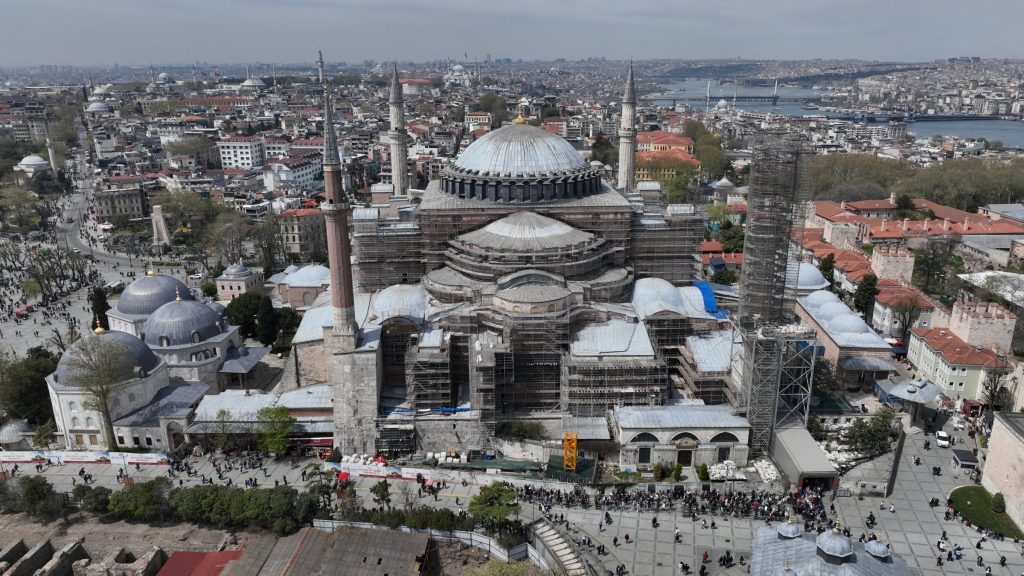When I first visited Hagia Sophia Grand Mosque in 2019, I remember the calm and peace it brought me. At the time, it was still a museum, quiet and full of history. It was the kind of place that made you slow down and take a deep breath.
Now, five years later, it stands as a mosque once again, having reopened for worship in 2020. That same peaceful atmosphere is still present, perhaps even more so. People from around the world continue to visit, and with the recent restoration work, Hagia Sophia feels both renewed and timeless.
What surprises me most is how, many centuries ago, people were able to build something so detailed and beautiful. They didn’t have the kind of tools or technology we have today, yet they managed to create something that still amazes us. Every corner shows how much care and effort they put into it. It makes you stop and think about how powerful human skill and creativity can be.
As part of these efforts, important steps have been completed to preserve the 1,486-year-old Hagia Sophia Grand Mosque. The work included holistic planning, structural modeling, ground condition assessments, and earthquake safety measures. All of this has been done with care, recognizing its significance as a UNESCO World Heritage site.
The mosaics inside Hagia Sophia’s dome are among its most precious features. These intricate artworks reflect the building’s rich Byzantine heritage and are a vital part of its historical and cultural identity. Having survived centuries of change, they continue to inspire awe in visitors from around the world.
To protect these mosaics during the restoration, all work on the dome will be carried out from the outside. The lead coverings will be removed, repaired, or replaced as needed. In order to shield the structure from weather conditions and prevent damage to the mosaics, the dome will be temporarily enclosed with a steel frame and a specially designed cover.

With the oversight of the scientific board established for Hagia Sophia, the implementation phase has now begun. Recent studies and analyses have shown that the main dome requires structural reinforcement. As a result, Hagia Sophia is now entering the most extensive and comprehensive restoration in its history. The focus will be on strengthening the building against earthquakes while preserving its original architectural form with great care.
To allow worship and restoration work to continue at the same time, a steel platform supported by four main columns will be built inside the mosque. This platform will reach a height of 43.5 meters, providing safe and stable access for restoration teams without interrupting daily prayers.
When I spoke with professor Ahmet Güleç, the Scientific Board member overseeing the restoration of Hagia Sophia, he shared insights into the ongoing work. He explained that to allow both worship and restoration activities to continue simultaneously, a large steel platform will be constructed inside the structure.
He explained that the main work being done at the moment is focused on the exterior of the mosque. “The old plaster has been removed, and we will apply new plaster and make necessary joint repairs to protect the building from the elements,” he said. “We are using materials that are historically appropriate, following formulas we’ve carefully prepared.”
Turning to the dome itself, Güleç shared that some initial drilling has been done to assess its condition. “The dome isn’t perfectly round. There are segments that need attention. We’ve found some areas filled with rubble or patched with wood. We’re working to balance the structure better so that it can withstand potential earthquakes.”
In my conversation with professor Asnu Bilban Yalçın, another member of the Scientific Board overseeing the restoration of Hagia Sophia, she explained that the restoration efforts have been ongoing for over a decade and are progressing step by step.
Yalçın highlighted the recent acceleration of work, particularly with the preservation of the eastern and northern facades. “The restoration of the dome is now the most crucial phase,” she emphasized.
She also reflected on the long history of Hagia Sophia, mentioning the significant repairs it has undergone during both the Byzantine and Ottoman periods. “Given that we are using modern techniques and technologies for this restoration, I believe a new chapter is being written in Hagia Sophia’s history,” Yalçın stated.
Yalçın also mentioned that the Directorate General of Foundations, under the Ministry of Culture and Tourism, has kept UNESCO fully updated on the ongoing restoration process. “Every step of this restoration presents new challenges. I’ve been part of this project for a long time, and it’s a structure that always brings surprises. The work ahead won’t be easy, but we’re committed to it. The Scientific Board is highly detailed, meeting regularly and working tirelessly to ensure every aspect is carefully handled.”


